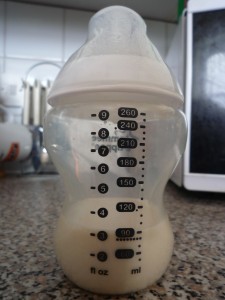All quantities in this article are representative of the formula milk designed for new born, and nutritional make up of mothers milk in the week after birth. Early nutrition has been chosen for this comparison for this article as this is the most important stage of baby nutrition, and will have the greatest impact its development. It is worth noting that nutritional quality of mothers milk does vary dramatically based on the nutrition of the mother, and the values used in this article are averages.
Macro-nutrients
Bellow is a table comparing the macro-nutrient content of formula milk and breast milk.
| Macro-nutrient | Amount in formula milk | Amount in breast milk |
|---|---|---|
| Energy | 275kj (66kcal) | 293kj (70kcal) |
| Protein | 1.3g | 1.1g |
| Whey (from cow milk) | 0.8g | n/a |
| Casein | 0.5g | 0.3g |
| lactoferrin | n/a | 0.2g |
| a-lactalbumin | n/a | 0.3g |
| IgG | n/a | 0.001g |
| IgA | n/a | 0.1g |
| lysozyme | n/a | 0.05g |
| albumin | n/a | 0.05g |
| Carbohydrates | 7.4g | 6.9-7.2g |
| of which are sugar | 7.3g | 7g |
| of which are lactose | 7.0g | 6.4-6.7g |
| Fibre/ oligosaccharides | 0.0006g | 0.5g |
| Total Fat | 3.4g | 4.2g |
| -of which are saturates | 1.5g | 2.27g |
| -of which are unsaturated | 1.9g | 1.93g (~0.152g being CLA) |
| -of which is arachidonic acid (AA) | 6.4mg | 15mg |
| -of which is doscosahexaenoic (DHA) | 6.4mg | 13.4mg |
The protein and carbohydrate content of both formula milk and breast milk is similar, with the formula providing slightly more protein and carbohydrates than breast milk. The quality of breast milk protein is slightly higher than that of formula milk, because the amino acid ratios in breast milk more accurately represent the amino acid requirements for the baby. In order to compensate for this, formula milk contains slightly more protein to ensure the baby obtains all the amino acids it requires. Breast milk also contains immune supporting proteins such as IgA and IgG which formula milk doesn’t contain. These antibodies will support the immune system of the new born baby and offer protection, which is not found in formula milk.
The carbohydrate content is quite comparable in in both sources, however, breast milk does contain much more oligosaccharides, which are prebiotics, and help to populate the digestive system of the baby with beneficial bacteria, which offer a range of benefits. Breast milk contains more fatty acids then formula milk, which provides more calories for the baby and more essential fatty acids. Breast milk contains much more essential omega-3 fatty acids (EPA and DHA), which are essential for brain development.
From the table it is clear that breast milk, contains a much more desirable composition of all the macro-nutrients for the growth and development of the child.
Vitamins
Bellow is a table comparing the vitamin content of formula milk designed for new born babies, and the average vitamin content of breast milk in the first week after birth.
| Vitamin | Quantity in formula milk | Quantity in breast milk |
|---|---|---|
| Vitamin A | 54µg | 164µg |
| Vitamin D3 | 1.2µg | 1.125-1.875µg (including various metabolites) |
| Vitamin E | 1.1mg (alpha-tocopherol) | 0.134 (mixed tocopherols and tocotreinols) |
| Vitamin K | 4.4µg (as vitamin K1) | 0.11µg (as vitamin K2) |
| Vitamin C (ascorbic acid) | 9.2mg | 4mg |
| Vitamin B1 (thiamin) | 50µg | 21µg |
| Vitamin B2 (riboflavin) | 116µg | 35µg |
| Vitamin B3 (niacin) | 430µg | 180µg |
| Vitamin B5 (panthenoic acid) | 330µg | 67µg |
| Vitamin B6 | 53µg (as folic acid) | 14µg (as folate) |
| Vitamin B12 (cobalamin) | 0.18µg | 0.1µg |
| Vitamin B7 (biotin) | 1.5µg | 0.6µg |
From the table it is clear that formula milk does contain a much greater proportion of all vitamins than breast milk. The majority of vitamins in the formula milk are synthetic, and there is much evidence to show that synthetic vitamins (with the exception of foate/ folic acid) are not absorbed as well as vitamins in their natural forms. In order to compensate for this reduction in absorbance formula milk is fortified with a greater concentration of synthetic vitamins to ensure a significant amount is absorbed.

Image courtesy of Ambernectar 13
Aside from being synthetic, there are other factors which affect the bio-availability and biological value of nutrients. Looking at vitamin K, it can be seen that formula milk contains the vitamin in the K1 form, where as it is in the K2 form in breast milk. The K1 form is the plant form, which is abundant in dark leafy greens such as kale, and the human body cannot use the vitamin in this form. Vitamin K1 must be converted into the K2 form inside the body by the resident probiotics before it can be utilized by the body. K2 is the animal form, and can be found in a number of fermented foods such as cheese and fermented soya. The conversion from K1 into K2 in the body is not very efficient, and is very variable depending on the probiotic population in the digestive system. This means that obtaining vitamin K as K2 is much more desirable and biologically valuable than the K1 form.
Vitamins in breast milk come with a number of co-factors and metabolites, and this has been demonstrated to be true at least with vitamin D3. Co-factors and metabolites increase the bio-availability of of vitamins, and can be utilized by the body in various metabolic pathways without the need for conversion, making vitamins and metabolites more valuable than the vitamin in a single state.
The comparison of vitamin E in breast milk and formula is of great interest. The term ‘vitamin E’ refers to 8 different compounds – 4 tocopherols and 4 tocotreinols; all of which are needed for optimum health. Formula milk only contains alpha-tocopherol, which is the most abundant of the vitamin E molecules in our body and diet, whereas breast milk contains a much lower amount of vitamin E, but it is made up of all eight molecules – providing a broader spectrum of benefits. Tocotreinols have demonstrated much more potent antioxidant properties than tocopherols, and are associated more with the protection of nerves, in particularly the brain, whereas tocopherols protect all other cells. The large amount of alpha-tocopherol in formula milk may be to try and compensate for the lack of tocotrienols. It is very common for synthetic vitamin E to only contain alpha-tocopherol as other forms are extremely hard to synthesise.
Minerals
Bellow is a table comparing the mineral content of formula milk designed for new born babies, and the average vitamin content of breast milk in the first week after birth.
| Mineral | Amount in formula milk (per 100ml) | Amount in breast milk (per 100ml) |
|---|---|---|
| Potassium | 65mg (as citrates, chlorides, and iodides) | 58.7mg |
| Chloride | 41mg | Variable due to diet. Approx 3x higher than blood concentration of mother. |
| Calcium | 50mg (as phosphates, citrates, hydroxides) | 22.3mg |
| Phosphorus | 26mg | 4mg-25.2mg (very variable) |
| Magnesium | 5.1mg (as chlorde) | 3.1mg |
| Iron | 0.53mg (as sulphate) | 0.47mg |
| Zinc | 0.5mg as sulpate) | 0.2mg |
| Copper | 40µg (as sulphate) | 32µg |
| Manganese | 7.5µg (as sulphate) | 0.11µg |
| Flouride | less than 0.3µg | 0.17µg |
| Selenium | 1.5mg | 0.0104µg |
| Iodine | 12µg | 0.54mg to 217mg (median average 6.2mg) |
| Sodium | 17mg | 16.2mg |

Image courtesy of mgstyer
From the table it is clear that the mineral content of both breast milk and formula milk is quite comparable, but generally formula milk contains slightly more – this, again, is likely to be due to bio-availability. The minerals in breast milk will be bonded to amino acids of other nutrients which the body readily can absorb and utilize, where as formula milk contains minerals in a mixture of forms from oxides to chelates (chelates being amino acid bonded minerals). Oxides and sulphates are not as readily absorbed by the digestive system, and so a higher concentration of these mineral compounds is required to ensure enough is absorbed.
Iodine is the only mineral which is contained in much higher quantities in breast milk than formula milk. Iodine is essential for brain development, and it is very important for babies to obtain enough iodine, but it can be very toxic and cause severe damage in high concentrations. Formula milk contains a safe amount of iodine, which cannot cause damage to new born babies but the concentrations of iodine are quite low for the babies requirements. Mothers milk, although very variable, provides a more optimal amount for proper development, and will not be toxic to the child. The great difference between formula concentration of iodine and breast milk is will be to ensure the safety of the baby, not to ensure optimum nutrition.
All minerals in the above table are beneficial aside from fluoride. Fluoride concentrations must be measured in formulation milk as it is incredibly toxic, and damages the nervous system. Fluoride is present in the powder as a result of processing, and its concentrations must be carefully regulated. Fluoride levels stated in this formula are considered safe, but a lower concentration is always more desirable, making breast milk much more desirable.
Other significant nutrients
Bellow is a table comparing the additional nutritional content of formula milk designed for new born babies, and the average vitamin content of breast milk in the first week after birth.
| Nutrient | Amount in formula (per 100ml) | Amount in breast milk (per 100ml) |
|---|---|---|
| Choline | 10mg | 6.2mg |
| Taurine | 5.3mg | 4.19mg |
| Inositol | 3.4mg | 3.6mg |
| L-carnitine | 1.1mg | 0.1mg |
| Nucleotides | 3.2mg | 1.2mg |
The content of these nutrients in breast milk and formula milk is comparable, with formula milk generally containing a higher concentration of these nutrients with the exception of inositol. Formula milk does contain a significantly higher concentration of L-carnitine, which is an amino acid based compounds required for the metabolism of fatty acids. The nutritional requirement of a new born baby for L-carnitine has not been established.
Summary
Breast milk, from healthy mothers who eat a nutritious diet, is much more beneficial for new born babies. The nutrients from this milk will be more bio-available and beneficial for the baby. Breast milk is especially beneficial for brain development, as it provides more essential fats which are required for brain growth and tocopherols which protect the brain from radical damage. Breast milk also contains unique prebiotics and proteins which support the immune system and digestive system. Current data and analysis shows that there are no nutritional advantages to using formula over breast milk.
However, formula milk is comparable to breast milk, and will provide an infant with all the essential nutrients it requires. This makes formulation a suitable replacement for those who cannot breastfeed, or if the diet of the mother is poor.
%CODE_BREAST%
References
Main image courtesy of nathangibbs

